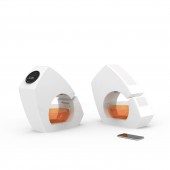DESIGN NAME:
Ocha 2.0
PRIMARY FUNCTION:
Customisable Tea Maker
INSPIRATION:
In India the widespread popularity of tea as a recreational drink began in early 20th century. There are different methods of making tea with respect to geography and culture as people prefer different flavours of tea. The type of tea is also personalised according to the mood of the person. Brewing tea is a skill based activity. The existing tea makers are totally void of customisation as even sugar and strength of tea is difficult to manipulate. The interface is also very clunky and not that intuitive to the user.
UNIQUE PROPERTIES / PROJECT DESCRIPTION:
Brewing tea is a play between tea dust, infusion rate, quantity of milk, not the least the amount of sugar as well to give indeed a cup of perfect tea that tingles your senses. Presenting Ocha 2.0, the next generation tea brewing experience. Ocha 2.0 is a cocktail of all conventional brewing experiences. The rule in design is “form follows function”, likewise in the case of Ocha 2.0 it has redefined the rule as “art follows technology”. Loaded with options such as customising, scheduling tea with Internet of Things as the base.
OPERATION / FLOW / INTERACTION:
Ocha 2.0 can be operated by user in two different ways. Either with the help of the mobile application that comes along with the product or with the help of the User Interface embedded on to the product itself.
Ocha 2.0 comes up with a central display console comprising of a display button placed right at the centre of the console that helps in selecting the various options on the menu. It also has a control dial along with two push buttons embedded on either side.
The application make it possible to operate Ocha remotely with the help of IoT (Internet of things).
PROJECT DURATION AND LOCATION:
The project started in February 2015 in IIT Kanpur/India and finished in January 2016 in IIT Kanpur/India.
FITS BEST INTO CATEGORY:
Home Appliances Design
|
PRODUCTION / REALIZATION TECHNOLOGY:
The entire design was made around the field research insights. Few of them are listed as follows:
1.Brewing tea varies with respect to location and culture
2.At home different people prefer different flavours of tea
3.Most of the time user only needs 4 to 5 cups of tea in one go
4.People feel comfortable using milk and milk powder but not capsules
5.Children cannot make tea easily as it involves risky steps
6.Amount of tea dust, sugar, time, temperature all are skill based
7.Sometimes people feel very lazy to brew a cup of tea in the morning/evening
8.Flavour of tea is also depends on the mood of the user.
9.People wish to have a cup tea after getting back from the tiring days work.
Ocha is proposed to be made as a sturdy and light device in an eye-catching package using ABS (Acrylonitrile butadiene styrene)+PC(Polycarbonate) by injection moulding process.
SPECIFICATIONS / TECHNICAL PROPERTIES:
Ocha 2.0 is proposed to be made using ABS(Acrylonitrile butadiene styrene)+PC(Polycarbonate) with a matte finish. The dimensions of the product are 275mm tall, 390mm long and 100mm wide. It is available in two colours i.e. matte black and pearl white.
TAGS:
Tea maker, Home appliances, Smart home products, Internet of thing, User centric design, Industrial design, Physical Product interaction
RESEARCH ABSTRACT:
To understand and design a user friendly tea maker which can make custom types of tea. An extensive user centric research was done on nuclear families, teenagers, elderly and novice users in a typical Indian household. The methodologies include visual ethnography, interviews, observations, field study, contextual enquiry, human action cycle and task flow analysis.
CHALLENGE:
One of the most challenging part of the design was to design the stirring mechanism which would replicate the efficiency of using a spoon to stir. Ocha uses a unique methodology for stirring the ingredients within. Achieving the stirring action without the use of any external parts led to the most innovative feature of Ocha 2.0.
It has a rotating platform that holds the glass jar in place with the help of an electromagnetic groove which is eccentric to its rotating axis.
The circular metal ring at the bottom of the glass jar falls in line with the electromagnetic groove so that the jar could be held firm.
This positioning on the whole helps the jar in moving along an eccentric path which in turn ensures thorough stirring of the ingredients within the jar.
ADDED DATE:
2016-02-28 00:11:16
TEAM MEMBERS (2) :
Designer : Vimal C and
IMAGE CREDITS:
Image #1, #2,#3,#4,#5 : (3D modeling and Rendering) Sachin NP
PATENTS/COPYRIGHTS:
Patent pending
|









